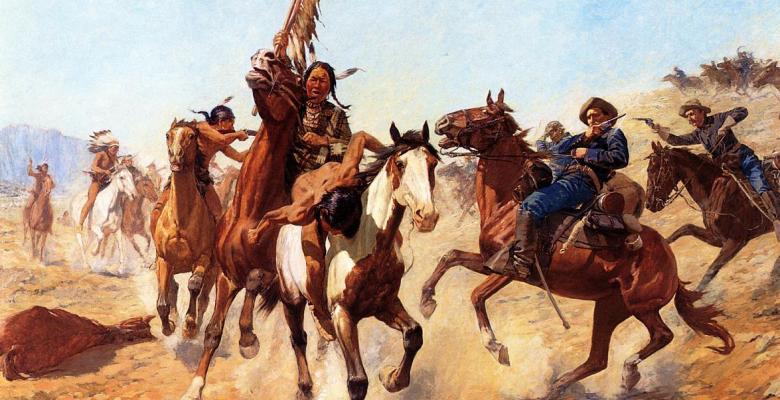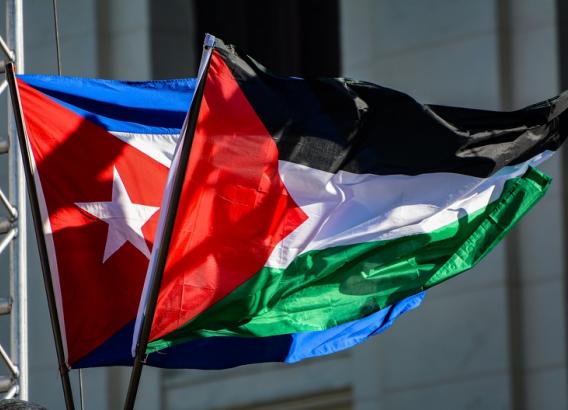Against Oblivion: Native Indian Peoples and the Identity of the United States

North American cinema produced and disseminated a classic genre that, in most countries of the world, Cuba included, would acquire outstanding popularity starting in the late 1940s, still maintaining its presence through television. Based on the real basis of continental expansion and the rise of capitalism in the United States, in the pre-monopoly stage, it entertained and fascinated audiences, with an attractive format. Thus, a vision took root in the culture of that nation and beyond its borders, which, behind the brave and heroic image of settlers who moved on horseback in pursuit of the conquest of virgin territories and felled opponents, hid and distorted the process of dispossession, ethnocide and extermination of the native North American peoples. This promoted a fallacious conception of American identity, which the world would accept as legitimate.
These are the familiar cowboy films - or Westerns, also known as westerns or cowboys -, the first of which came to light at the beginning of the last century, in still silent cinema, in black and white, but which they universalize and reach their top splendor later, with sound and color, exposing landscapes that highlighted meadows, plains, mountains, forests, rivers, wild and desert environments, with an infinite blue sky and an intense sun, all of which served as framework to scenarios that were repeated over and over again. Isolated ranches, typical towns, in which there were no shortage of saloons, with drinks, card games, fights, duels and shootings, nor banks, which would be robbed, or the sheriff's office, commissioner or sheriff, with its corresponding cell, improvised gallows and eventual hangings, along with characters such as the barber, who functioned at the same time as a dentist, and the undertaker. Idealizing honest gunmen or vigilantes, supposedly defenders of order and citizen tranquility, who faced gang members, as well as the gallant military troops of the Cavalry, with their blue uniforms, as symbols of the fight of the civilizing and enlightened spirit against barbarism of the Indians, such films spread a model of individualistic society in which the law of the strongest prevailed. The stereotyped vision of the several Indian tribes (Apaches, Navajos, Comanches, Sioux, among the best known), whose copper skin gave rise to the discriminatory label of “redskins”, characterized with a ferocity and cruelty justifying their massive and brutal extermination, a degrading racist pattern would be established that was added to the prototype of the black-skinned slave, of African origin. Like the other side of the same coin: that of intolerance a and white supremacy.
With an approximate figure that today ranges between 6 and 9 million, according to 2020 census records and subsequently updated statistical estimates, between 2022 and 2023 - which do not allow more precise details -, the native Indian population, belonging to some 570 tribes, which They represent less than 3% of the inhabitants in the United States, living mainly in areas called reservations, where they were located in the last decade of the 19th century. The state with the highest concentration is California, while the town with the largest population is located around the city of New York, in communities often co-opted by the American way of life, where casinos operate and where the figure of the Indian it’s exploited in a degrading way, for tourist purposes, through religious shows, with traditional dances and songs. Such territories are inherently sovereign, although it’s a limited sovereignty, as they are legally dependent on the North American federal government. In terms of human rights, the Indian has not stopped being discriminated against, nor has they achieved full social integration. The current reality of these native peoples, decimated and subjected, continues to reproduce relations of segregation and domination, although reactions of cultural and legal resistance are not totally absent, which do not achieve the capacity to convene or support on a national scale.
On December 29, there was another anniversary of the most pathetic and shocking events in the history of the United States, disfigured in school textbooks, in the press and in the imaginations of everyday life, the significance of which should not be overlooked. It’s an eloquent evidence or expression of the form adopted and the consequences caused by the development of capitalism and the transition to the imperialist stage in said country. In North American society Indian has been repeatedly presented as a negative and adulterated element.
On the morning of the aforementioned day, in 1890, the massacre of approximately three hundred Indians, including women, elderly people and children, took place in the town of Wounded Knee - in the Pine Ridge area, in the state of South Dakota, where still The reservation remains, understood as a confinement area, by the soldiers of the Seventh Cavalry Regiment. It was the last and definitive action of the US government in the process of subduing and subjugating the authentic native inhabitants of the North American territories.
When the named territory became a new state of the American nation in 1889, an acute defensive reaction occurred on behalf of Sioux Indians, which was manifested, among other things, through the celebration of a religious ritual practice called the “ dance of the spirits”, based on the belief that in this way their ancestors would return, recover their lands and the whites would disappear by divine punishment. The ceremonies generated fear of a possible imminent uprising, which led to the mobilization of the Seventh Cavalry Regiment and led to the atrocious repression of the Indian community, which led to the murder of the famous chief Sitting Bull and the subsequent massacre at Wounded Knee.
Although a stage was sealed with the massacre, as this event concluded the process of conquest and expropriation of territories of the Native American Indians, their drama and struggle would continue, throughout the 20th century, to the extent that that the confinement of their life to the reservations trampled on elementary human rights and their voices and claims have continued through the North American Indian Movement, through protest actions, denunciations and civil disobedience. One of its leaders, the activist of Sioux origin Leonard Peltier, was unjustly arrested and convicted fifty years ago, in 1973, for acts of protest that led to false accusations, to two life sentences, and is still in prison.
Such activities have not disappeared from the sociopolitical or legal scene, although the dominant ideological apparatuses and media have silenced their resonance as much as possible or minimized them. This movement has maintained demands, for example, under the protection of the United Nations Declaration on the Rights of Indigenous Peoples, regarding issues related to the sovereignty of the territories of residence and tribal jurisdictions, presenting motions, with little success, before the Supreme Court, and have demanded, with little success, through the International Labor Organization (ILO) certain labor rights, since, although the Indians of the United States are generally North American citizens, above all they define themselves as citizens of their own tribal affiliations and their geographic settlements on the reservations they belong to.
Expansionism and racism, in short, as a common denominator in a history of violence and oppression, which endures and extends to other communities, such as the so-called “minorities”, and among them, the black population and the immigrant population, which make up the complex multicultural, multiethnic and multiracial mosaic that is the United States, a nation that has lost memory and contact with its own history. The fight against forgetting and manipulation is essential.
Today, the essence of the defense of North American identity, which promotes the fight against everything that constitutes a manifestation of “anti-Americanism,” assumes that what’s authentic is the condition of the white, Anglo-Saxon and Protestant, that is, that which symbolizes those who founded the thirteen colonies, which became the nascent American nation, on July 4, 1776, as a result of the Revolution of Independence. Thus, the dominant culture imposes an “official” history that omits the original peoples, the native Indians, as the genuine, autochthonous subjects of that history.
Translated by Amilkal Labañino / CubaSí Translation Staff













Add new comment